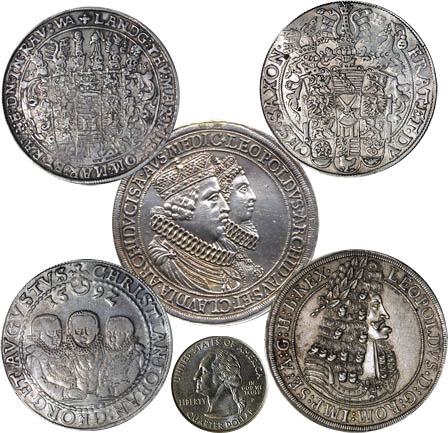Thaler
From the Quicksilver Metaweb.
a Baroque Cycle spanning page on pieces of silver - the Thaler.
Stephensonia
30 pieces of silver ...
Wikipedia: Thaler

Various thalers from Germany and Austria with size comparison to an
United States quarter (bottom center). Clockwise from top left:
Saxe-Altenburg 1616 Thaler reverse, 1592 Saxony Three Brothers
Thaler reverse, 1701 Austria (Hall) Thaler of Leopold I (the Hog-mouth)
obverse, 1592 Saxony Three Brothers Thaler obverse. Center: 1635
Austria (Hall) Double Thaler obverse.
The Thaler was a silver coin used throughout Europe for almost four hundred years. The roots and development of the thaler-sized silver coin dates back to the mid-1400s. As the fifteenth century drew to a close the state of much of Europe's coinage was quite poor because of repeated debasement induced by the costs of continual warfare. This habitual debasement had reached a point that silver content in coins had dropped in some cases to less than five percent, making the coins of much less individual value than they held before. Countering this trend with the discovery and mining of silver deposits in Europe, Italy began the first tentative steps toward a large silver coinage with the introduction in 1472 of the lira tron in excess of six grams, a substantial increase over the roughly four gram gros tournois of France. 1474 saw a nine gram lira issued, but it was in 1484 that Archduke Sigismund of Tyrol issued the first truly revolutionary silver coin, the half guldengroschen of roughly 15½ grams. This was a very rare coin, almost a trial piece, but it did circulate so successfully that demand could not be met. Finally, with the silver deposits being mined at Schwaz to work with and his mint at Hall, Sigismund issued in 1486 large numbers of the first true thaler-sized coin, the guldengroschen (great gulden, being of silver but equal in value to a gold gulden). The guldengroschen, nicknamed the guldiner, was an instant and unqualified success. Soon it was being copied widely by many states who had the necessary silver. The engravers, no less affected by the Renaissance than other artists, began creating intricate and elaborate designs featuring the heraldric arms and standards of the minting state as well as brutally realistic, sometimes unflattering, depictions of the ruler or monarch.
By 1518 guldiners were popping up everywhere in central Europe. In Bohemia, then controlled by the Habsburg monarchs, a guldiner was minted of similar physical size but slightly less fineness that was named the Joachimsthaler, from the silver mined at a rich source near Joachimsthal (St. Joachim's Valley, Czech: Jáchymov) (now in the Czech Republic) where thal means "valley". St. Joachim, the father of the Virgin Mary, was portrayed on the coin. This new thaler was finally the coin that Europe was looking for to create a standard for commerce. As silver flooded into the European economy from domestic and overseas sources, thalers and thaler-sized coins were minted all over with equivalent coins such as the crown, daalder from which the English word dollar is derived, krona, and eventually the peso being issued and in widespread use. Indeed, in England the word dollar was in use for the thaler for 200 years before the issue of the United States dollar, and until the half crown ceased to be used following decimalization in 1971, the term "half a dollar" could be heard for "half a crown". The zenith of thaler minting occurred in the 17th century with the so-called "multiple thalers". Some of these coins reached colossal size, nearing a full pound (nearly 375 g) of silver and being over 12 cm in diameter. These are very rare, often costing tens of thousands of dollars, and are highly sought after by serious collectors of thalers.
The Thaler was introduced and became the most spread currency in Scandinavia under the name Daler during the early 17th century. The Daler was in circulation in (Denmark and Sweden) until 1873 when it was replaced by the Krona, the new currency introduced by the Scandinavian Monetary Union. Norway joined the Monetary Union and introduced the Krone in 1876.
The final thaler of Germany was issued in 1871, Austria's ended in 1867. No currency currently in circulation is named thaler. Several, however, are acknowledging its legacy with their names: the dollar, used in several countries including the United States of America, Canada, Australia and New Zealand, and tolar, used in Slovenia.
Maria Theresa Thaler

Maria Theresa Thaler. Mint of Rome The Maria Theresa Thaler (MTT) coin, which has been used in world trade continuously since the first minted in 1741, has considerably extended the fame of Empress Maria Theresa, who ruled Austria, Hungary, and Bohemia from 1740 to 1780. Since 1780 the coin has always been dated 1780 and has been made by the following mints: Birmingham, Bombay, Brussels, London, Paris, Rome and Utrecht, in addition to the Hapsburg mints in Hall, Gunzberg, Kremnitz, Karlsberg, Milan, Prague and Vienna. Between 1751 and 2000 some 389 million have been minted. Since 1946, the Vienna Mint has produced over 49 million. For much of the early 1900s it was the official money of Ethiopia, with the Bank of Abyssinia issuing bank notes denominated in Thalers. It was one of the first coins used in the United States and probably contributed (along with the Spanish eight-bit dollar and the Straits dollar) to the US choice of a dollar as the main unit of currency. The Maria Theresa dollar was formerly the currency of Muscat and Oman, as well.
The coin remains popular in Africa and the Middle East to this day. It is a handsome silver coin with a portrait of the buxom Empress on the front and the Austro-Hungarian Double Eagle on the back. It is said that the low-cut gown she wears has added to the popularity of the coin.
It is 39.5 mm in diameter and 2.5mm thick, weighs 28.0668 grams and contains .752 oz of silver. It is .833 pure.